Ok, technically, this is not a GBB... but it uses gas... and ejects shells... so I reckon it's not entirely out of place here

This is a review I have written quite a while ago in german. I translated it for this forum, as I think, this is an interesting gun which never was produced as a modelgun.
Sorry for the length of the review!
Feel free to let me know any type-o's or falsely used english terms - it's not easy with all that "gun-tech-english"

Marushin M1887 "Guard's Gun"

Intro
It has been a long time since the release of the Marushin M1887 Terminator2 Shotgun here in Germany and even though I am a huge fan of shellejecting airsoft guns, for some reason, it has never found its way into my collection.
That I finally decided to import the long version of this gun had 2 reasons:
1. The wooden parts of the Marushin T2 Shotgun are plastic. I actually found this to be a huge disappointment, especially when I looked at the price tag (329,00 € back then). The wood on the M1887 „Guard’s Gun“ is real wood!
2. While I really like the old Terminator movies, I sill prefered the Wild-West-Look of the long M1887.
This M1887 was a special offer, it cost me ~280,00 € including shipping, customs and the seal of approval which is necessary here in Germany.
Anecdote: Realsteel
(This is a bit long, if you’re not interested, just ignore the following italic part)
John Moses Browning, one of the most famous developers (of not THE most famous developer) of firearms (128 patents for firearms, over 30 million guns are based on his creations like e.g. the slide – system that almost all modern pistols use) was commisioned by Winchester Repeating Arms Company in 1885 to design a new shotgun for them.
Winchester wanted something to seriously compete against the usual single- and doublebarrel break-action guns.
Browning tried to convince them to go for a pump-action shotgun instead of a lever-action model, but Winchester insisted on retaining their signature system.
Thus, they released the Winchester M1887 in the year – you probably have guessed it – 1887, a lever-action shotgun using 12gauge shells, shortly afterwards they also released a 10gauge version.
The M1887 was first available with a 28“ barrel (or 30“ depending on which source you want to believe) and had some success in the military and police forces. There, however, it was common practice to saw off the long barrel to give the gun a more agile handling.
Seeing this, Winchester released a Riot Gun Version in 1898 with a 20“ barrel.
Though the M1887 is regarded as the first successful repeating-shotgun, it was FAR surpassed in quality and sales numbers by the M1897 pump-action shotgun, also released by Winchester.
The M1897 was Browning’s design, too, so his recommendation to go for a pump-action system has finally been heard and it paid off.
(By the way, this was exactly the M1897 Tanaka’s „Trenchgun“ is based on  )
)
Meanwhile, the M1887 had its own issues:
The gun had a much higher price tag than a break-action gun, it was heavier and repeating the lever was tiresome after a while. Additionally, the blackpowder used in shotgunshells back then caused residues inside the mechanism, which ultimately led to jams and a damaged repeating system.
When smokeless blackpowder was invented at the end of the 19th century, which of course also found its way into shotgunshells, it became clear, that the construction of the M1887 was not sturdy enough to withstand the stronger power, this blackpowder developed.
Thus, Winchester released a follow-up model, the M1901, but only in 10gauge, to not compete with their own 12gauge M1897 pump-action.
At this time, however, lever-action firearms were already fighting a losing battle against other gun designs and production ceased in 1920.
From 1887 to 1901 Winchester built about 65.000 pieces of the M1887, followed by ~ 79.000 M1901.
Today, real M1887 are pretty rare and well preserved guns go as high as 3000 US$
That’s why several modern firearms manufacturer sell licensed reproductions of this shotgun.
The M1887s built by IAC, Norinco etc. are much cheaper than an original, old M1887 and of course, opposing to the old version, the new ones can reliably use modern shotgunshells.
The most famous real person, who has used an M1887 probably is Clyde Barrow, better known as „Clyde“ as in „Bonnie and Clyde“ 
On their rampage through the US of the early 30s, he used a 20“ Riot Gun Version of the Winchester M1887 (or an M1901 Riot Gun, depending on source), among other guns of course. He probably got this gun from a kidnapped and / or killed cop.
Regarding Barrow’s favourite guns, there’s some dispute: It was either his Browning BAR with sawed off barrel (called „Scattergun“) or 2 shortened, semiautomatic Auto5 12gauge shotguns.
Bonnie’s and Clyde’s car was a moving firearms-arsenal. When they were finally shot in 1934, the authorities found several BARS, semiautomatic Shotguns and pistols aswell as the mentioned M1887 / M1901 in their trunk.
The most famous fictional person, who has used an M1887 is of course the T-800, marvelously played by Arnold Schwarzenegger in James Cameron’s legendary action masterpiece „Terminator 2“ 
His M1887 had a sawed off barrel aswell as a shortened stock (as everyone here probably knows, this is the gun Marushin’s M1887 T2 is based on).
For the famous „Terminator-spin“ – the T-800 spinning the gun singlehandedly on his motorcycle, thus repeating it in a pretty cool fashion – they installed a much bigger lever on the shotgun.
For the movie, they actually used REAL M1887 shotung from the 19th century, those were not replicas!
Since then, the M1887 has found its way into several movies, like „Hot Fuzz“ (amazing movie by the way!) or „Ghost Rider“ (awful movie by the way!).
The first impression
The Marushin M1887 came in a normal box with the lower part being made out of styrofoam.
The box has a somewhat clumsy looking Wild-West-Look: Unconvincing woodgrain-print and the words „Guard’s Gun“ in an old-fashioned lettering, but as the box is otherwise littered with normal lettering, symbols and kanji, the intended Wild-West-Look is destroyed pretty thoroughly.
(The first few pics are bit too bright, sorry for that)

I removed the lid of the box and looked at what’s inside.
Besides the gun, there are 5 shells (here there are 10, bought 5 additionally), a small bag of BBs, a japanese manual, an adapter for the gas bottle and a hopup tool.
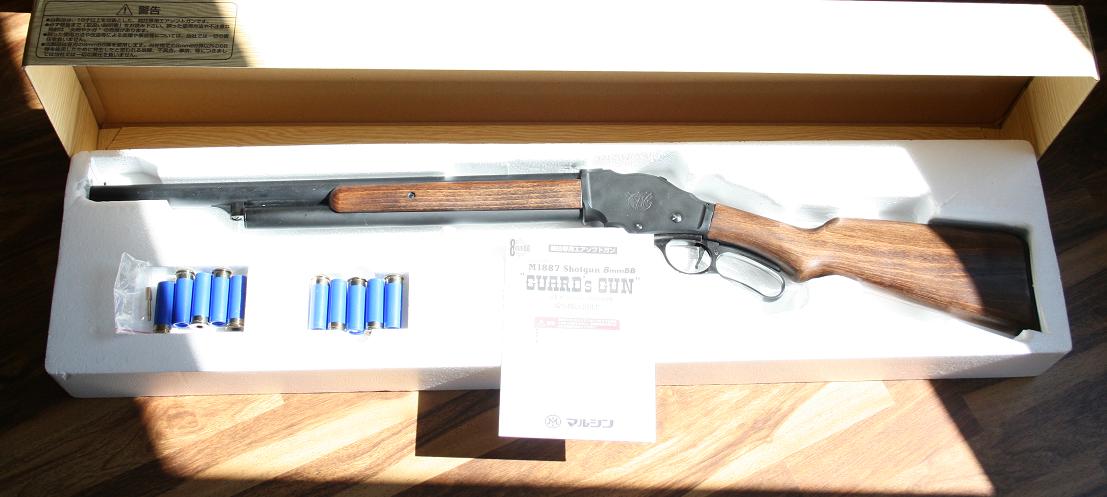
The first impression of the M1887 is VERY positive. It has a nice weight of 2392g and feels extremely sturdy. The length is just right, Marushin has met the right decision, to not copy the first M1887 with the long barrel, but the 20“ Riot Gun instead.
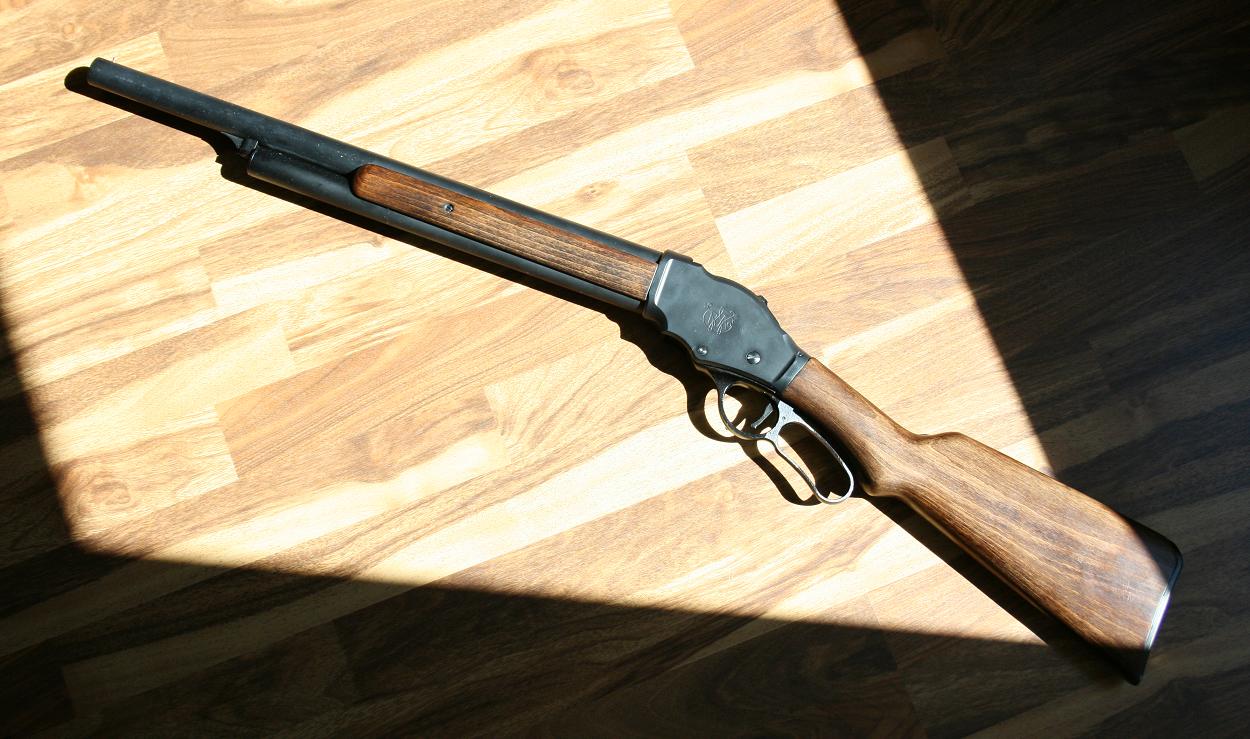
Unfortunately, the body is made out of plastic (possibly ABS), but it has a convincing, more or less dull finish, that doesn’t look like plastic until you look at it closely.
Barrel, magtube, buttplate, leverconstruction and the internals are all made out of metal, the handguards on both sides and the stock are made out of wood.
The gaps are a tiny bit too wide for my taste, but the gun is extremely sturdy! Nothing creaks, nothing wobbles, very nice construction overall!
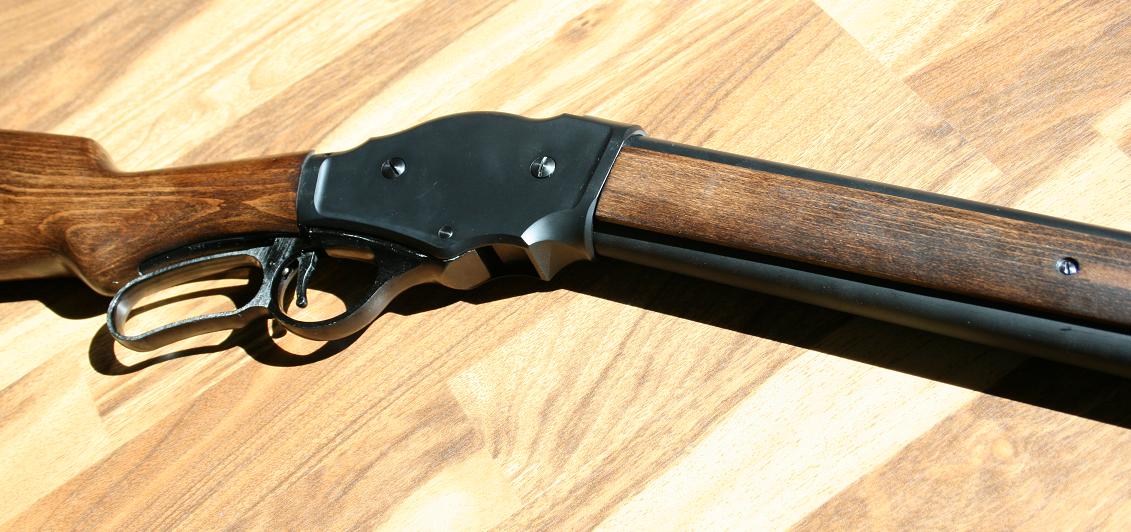
The wooden parts have a very good, heavy quality, unlike that of Marushin’s old M1 Carbine or their 98K. It does look a bit like walnut, but I reckon it’s something cheaper

The stock is tightly connected with the body, there’s not the slightest bit of play.

I have to point out, though, that the stock’s shape differs slightly from the original stock of an old M1887. The pistol grip of the old stock is a bit more pronounced, it has a sharper and steeper bend at the top and is overall a bit higher.
The Marushin stock has more similarity to those of the modern reproduction M1887s but it’s still not an exact copy.
Here’s a pic for comparison:
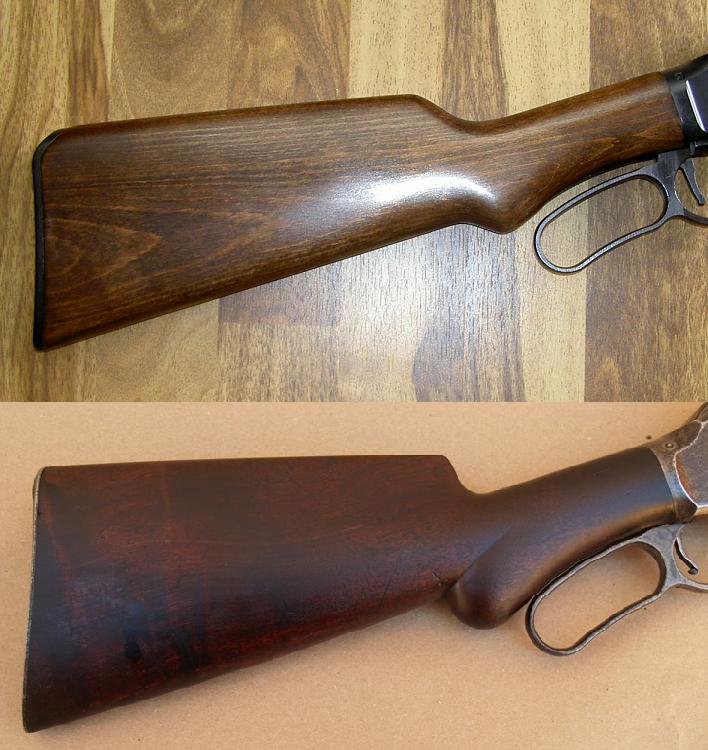
Top: Marushin M1887 stock
Bottom: Original, old M1887 stock
The handguards just slide into a gap at the front of the receiver and are fixated with a single screw on each side between the barrel and the magtube.
They sit pretty firm, only if you really use some force, you can move them less than a millimeter up and down inside the gap at the receiver.
Second impression – a closer look
The M1887 does not have many markings.
First of all, there’s the Winchester Repeating Arms Company Logo, which seems to be grooved into the side of the receiver. The logo looks alright, but could have been a bit more filigree for my taste.

Stamped into the underside of the stockmount – thus in a position, that is true to the original – there’s the lettering which hints to the realsteel manufacturer:
„Manufactured by the Winchester Repeating Arms Co.“
Marushin’s own markings are surprisingly small and almost blend into the original marking:
„Marushin Industry Co. Ltd Made in Japan“ just replaces the manufacturing location and year of the original. Well done!
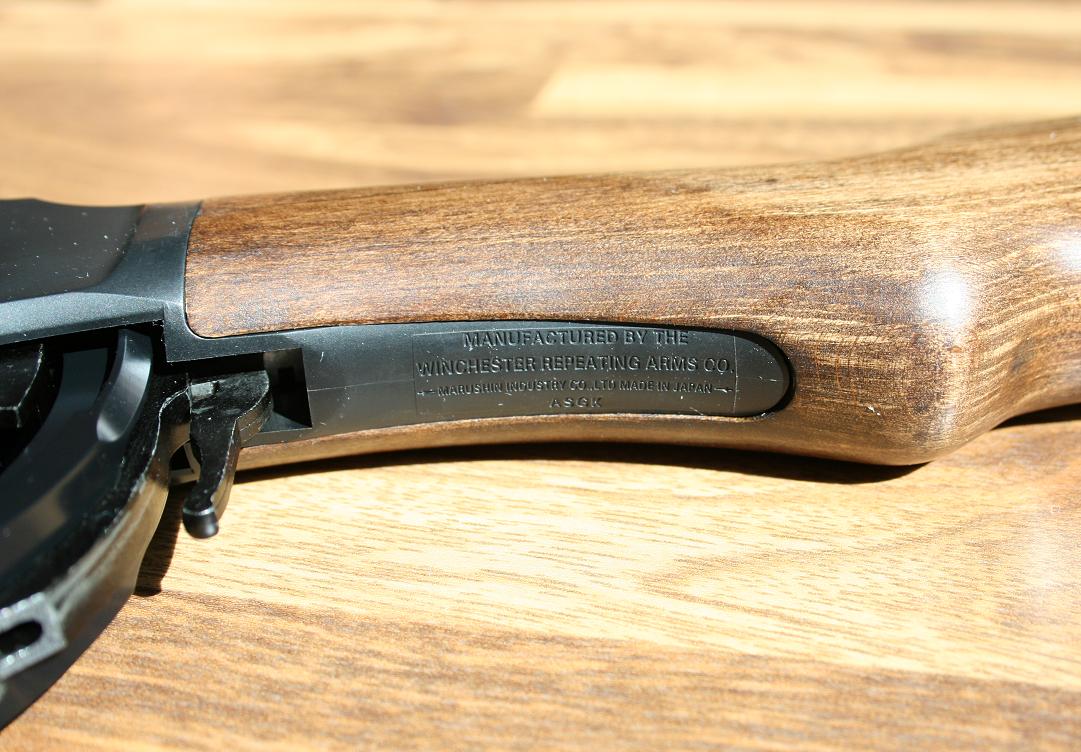
Finally, we have the obligatory „F in a pentagon“, the german seal of approval for legal airsoft guns. This has to be stamped into an important part of the gun by the national firing proof house after they tested the power of the gun (and made sure that it doesn’t fire full auto).
This, however, is not a run-of-the-mill „F“. It probably is the most unobtrusive and well hidden „F“ that has ever been stamped in Germany

You really have to open the lever mechanism to even see the seal! This is awesome, thanks a ton to the firing proof house in Munich!

The iron sights are, as you would expect from a replica of a gun that old, pretty puny.
A small brass orb serves as the front sight, the rear sight is a classic, pretty wide notch sight – this doesn’t exactly provide the impression of precise shooting, but hey, it’s a shotgun!

The muzzle seems almost scary, the outer barrel has an impressive diameter of 24mm.
About 50mm further inside, one can see some kind of „second innerbarrel“, a brass tube with a diameter of about 20mm. Not sure, what this is for...
Another 55mm further inside, so 115mm away from the outer barrel’s muzzle, the inner barrel ends. So this gun does have a pretty short inner barrel, which probably helps the 8mm BBs to make a good impression of the scattering of a real lead shot

Unfortunately, I wasn’t able to make a good foto of the 3 barrels...
Let’s take a look at the shells.
They are made out of a blue, pretty hard plastic, which unfortunately is a bit shiny (and I don’t mean „Firefly“ – shiny... yay, long live the nerd jokes!), the bottoms are made out of a brasscolored metal. The shells are heavier and sturdier than I would have expected, as so far I only knew the Maruzen M870 / M1100 shells (which are sturdy, too, but they weigh less and have a „softer“ feel to them).
The M1887 shells come in at over 20g each, so a fully loaded M1887 has an additional 100g of weight compared to an empty one.
In a direct comparison to a realsteel 12gauge shell, you can see, that the Marushin Version is a bit shorter and has a much thinner diameter.

The first explanation for this, that comes to mind, is, that Marushin made a replica of the 10gauge shells, not the 12gauge.
The second explanation might be, that any too close similarities to a realsteel shell were to be avoided at all costs – after all, japanese airsoft manufacturers have had quite a few bad experiences with too realistic replicas
(like Asahi in the 90s, their M40 sniper rifle was convertible via a kit to fire realsteel .22 bullets, thus it was forbidden, many were destroyed and the few that survived outside Japan are the most sought after Classic Airsoft guns nowadays; or a more modern example: Tanaka’s Cassiopeia Revolvers, which were banned for a similar reason).
The shells hold up to three 8mm BBs, which are filled in as one would expect: push them through an o-ring at the top of the shell, so that they drop into the shell‘s innerbarrel, which goes all the way through and ends at the bottom with a second, thicker o-ring.
As one would also expect, the power drops significantly, when more than 1 BB is fired at once.
Internals
At this point I usually tear down the airsoft gun and show some pictures of the internals, but to be honest, I don’t want to take that risk with the M1887.
I fear, that the lever-action mechanism is pretty complicated and that tiny springs and levers smash into my eyes once I open up the receiver ;)Maybe I will take pictures one day, should something break inside and I have to open it up to make repairs – but I hope not.
But of course, I can at least take a picture of the pulled down lever and everything you can see above it.
The mechanism of the realsteel is of course made up only of an arrangement of rods and maybe a few iron sheets, Marushin used this space for the gastank.
The lever pulls down easily and smoothly, the feel and the sound it makes while moving give an impression of sturdiness. The only downside is, that it moves down a bit TOO easily and smoothly. Hit the back of the stock with your hand and the lever sometimes moves down on its own accord – on the other hand... just don’t do that, it’s stupid behavior with a firearm anyway

Grab the gun how it is supposed to be grabbed and your fingers will prevent the lever from opening

When you open up the mechanism, you will also have access to the gas valve. I quickly asked myself why the hell of all places Marushin decided to put it THERE...
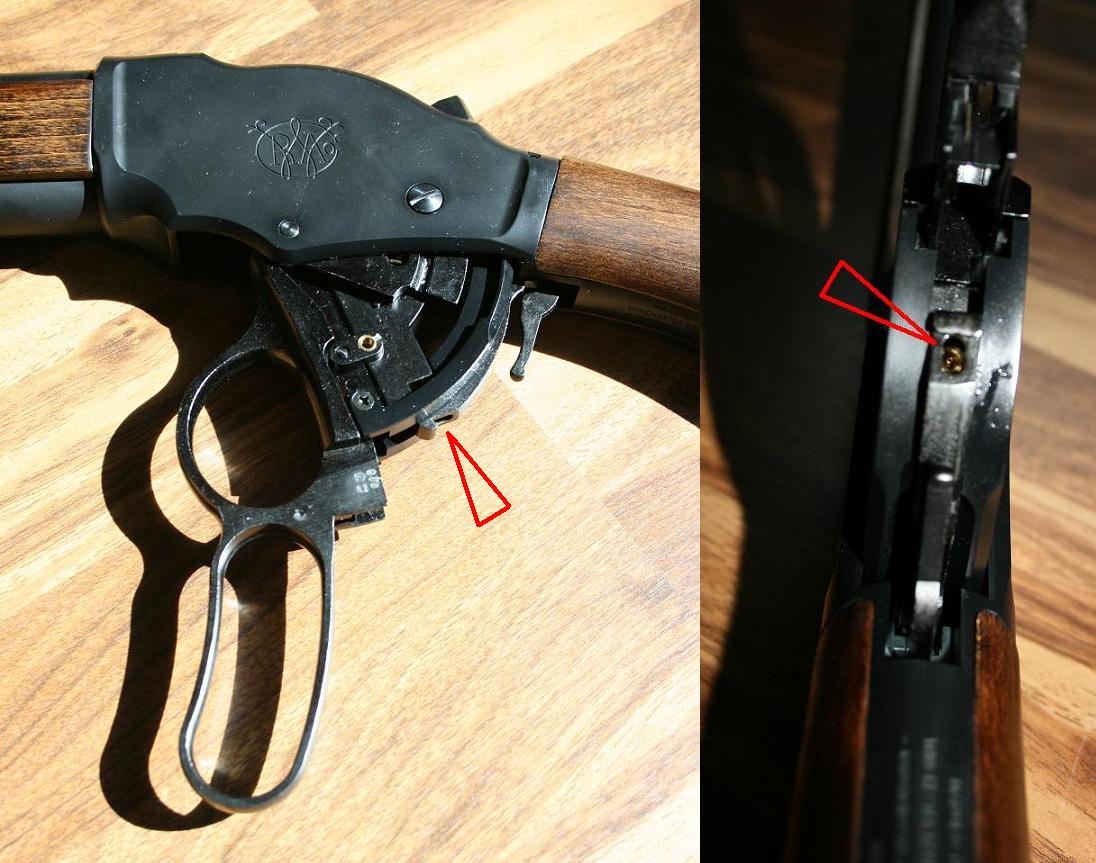
Preparing for firing
... as you need an adapter to fill in gas.
I tried several different bottles of gas without the adapter anyway, but to no avail, their filling-pieces were all too short. So I had to use the adapter.
Another issue: The adapter worked flawlessly with the plastic-filling-piece of Abbey Predator Ultra and 134a Gas, but of 6 different Greengas bottles, only ONE filling-piece fit.
Using the adapter on one of the other 5 bottles, the gas was going everywhere but not into the tank of the gun.
I had to fiddle around a bit until I found the best way (for me) to fill in the gas. As shown on the foto, I found it best to turn the M1887 upside down, fixate the lever with one thumb and use the free hand to push down the gas bottle.
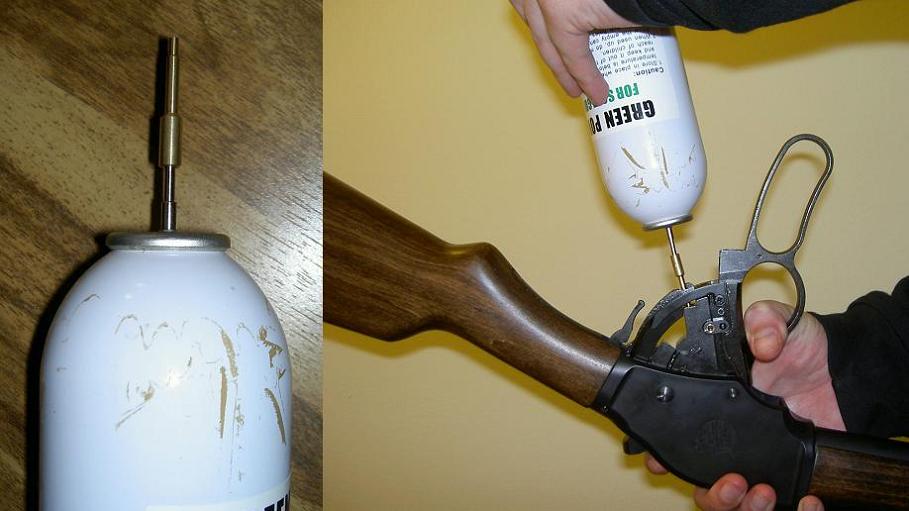
I had the M1887 testfired at the firing proof house with Greengas – just a short hint: Don’t use it with Greengas :)134a is more than enough!
No, I don’t say that because the gun might take damage from the stronger gas (it has no parts moved by gas, so it can take a lot of pressure), but because the shot gets ridiculously powerful with Greengas. More about that later.
Now the shotgun has to be loaded.
When there’s 1 – 3 BBs in each shell, they can be loaded into the magtube.
Unlike later pump-action shotguns or the „normal“ Winchester lever-action rifles, the M1887 does not have a seperate access to load the magtube.
You have to pull down the lever as far as possible to gain access to the barrel and the magtube.

Now you put a shell on top of the feeder. For this, you have to push it past the extractor at the left side of the receiver, this can be done pretty fast with a bit of practice.
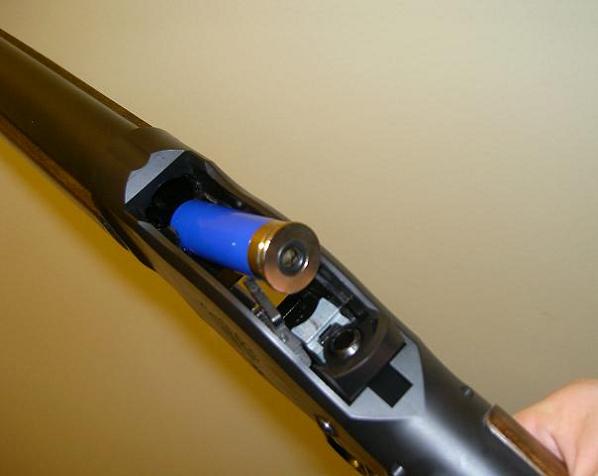

To get the shell into the magtube, you have to push the whole feeder down, until the shell is in a position low enough to be pushed forward into the magtube.
The best way to do this is to use your thumb to push it into the tube until the shell clicks into place inside and is not pushed out by the magtube-spring.
(The two words in this foto are of course: Lauf = Barrel, Laderohr = Magtube)
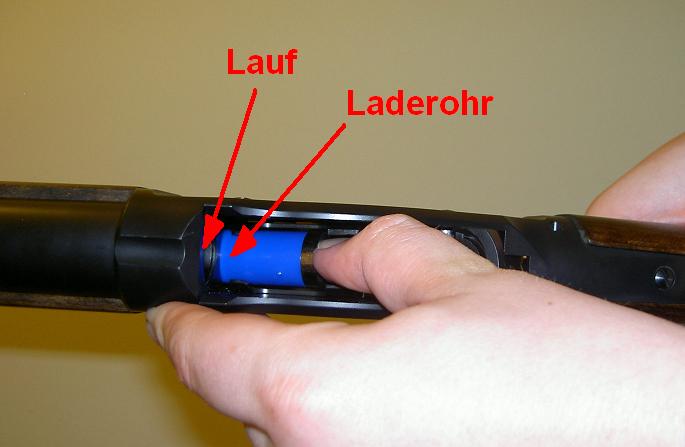
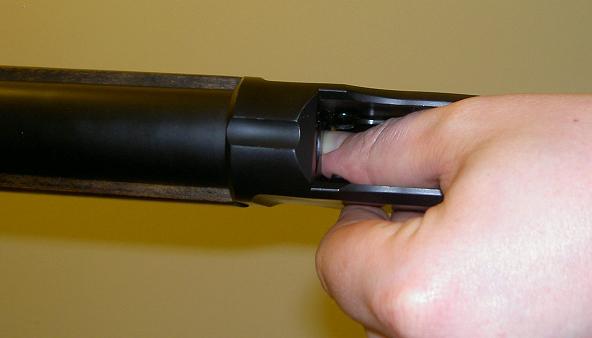
The feeder moves back up by itself.
Loading the gun really is pretty fiddly, but of course it is true to the original and it can be done quickly and fluently after same practicing. Warning, tiny injuries can occur while doing this, depending on the size of your hand!

You repeat that course of action until there are 4 shells inside the magtube.
Then you put a fifth shell on top of the feeder, but don’t push it down. Should the feeder not be in the top position, pull down the lever as far as it goes.
Now pull the lever UP to close the mechanism, thus the fifth shell is loaded into the chamber / barrel.
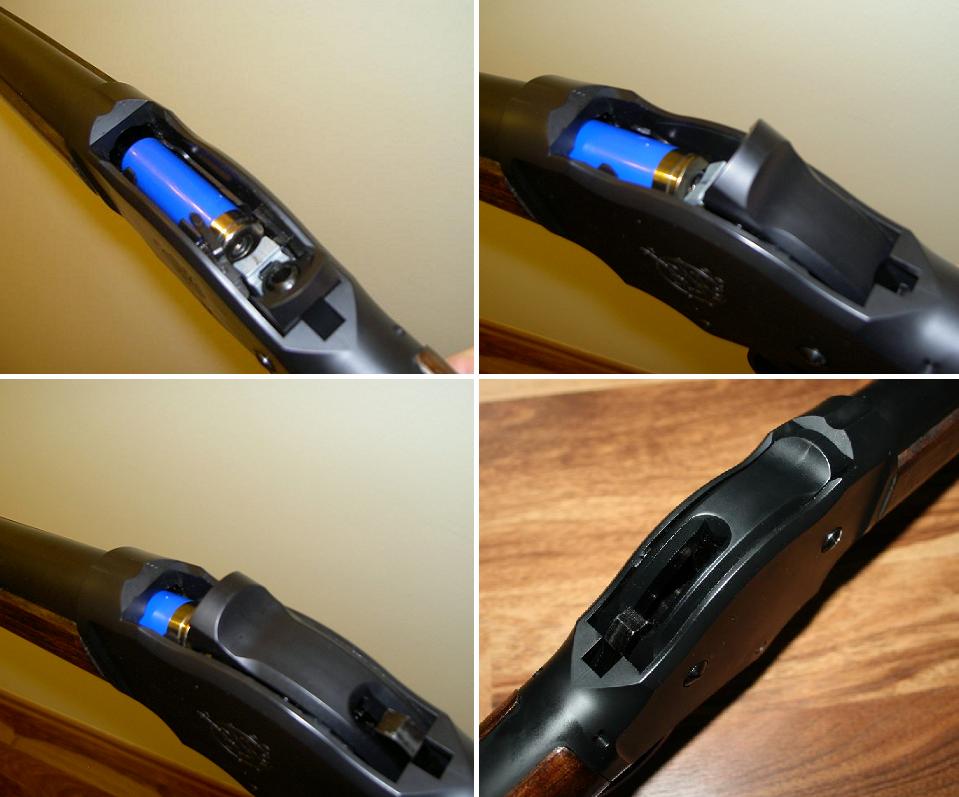
The machnism closes with a „clack“, followed by a fine „click“. The hammer is cocked.
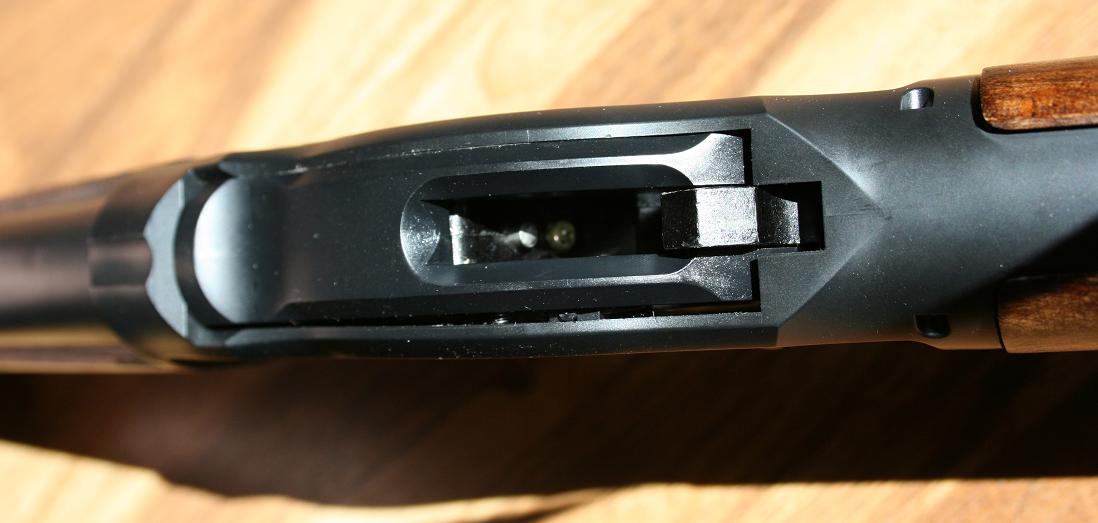
This probably is your last chance to realize, that the Marushin M1887 – just like its realsteel counterpart – does not have a safety :)Once it is loaded and cocked, you can fire, so take care when you handle the gun once you have reached that point.
Firing
When you now pull the trigger, the BB is (or the BBs are) fired out of the barrel.
It’s accompanied by an impressive „PLOP“, which testifies to the power behind the BB.
Using Greengas, the M1887 gets 0,35g BB to about 140 m/s, which is equivalent to 3,5 Joule

(this is the energy of a single 8mm BB, I don’t know how much the power drops with 3 BBs).
I don’t really want to know how it feels to be hit by such a shot and it’s the M1887s simultaneous blessing and curse, that it will hardly ever be played in an Airsoft game (which I don’t attend, I’m a pure collector anyways).
Besides the high power, the consistency of this gun deserves some praise: Firing 10 shots, there‘s only minimal variety to the measured BB speed, it only varies between 140 and 142 m/s!
I have not yet measured the power using Predator Ultra or 134a gas.
Now once you have fired the gun, you get to the fun part: Repeating it

The mechanism is rigid enough to not hold back when you do this, so move down the hand with the fingers inside the lever using a good amount of force and spped and the breech opens up and spits out the shell. You have to be dead inside to not get a huge grin on your face when doing this *g*
(In fact, you really HAVE TO repeat the gun with a decent amount of force and speed, otherwise, the shell is not thrown out, but just stays on top of the feeder)
Now pull the lever back up and the next shell is loaded into the chamber.
When you are familiar with the right amount of force you have to apply to the mechanism, you can fire, repeat, fire, repeat in a surprisingly quick succession.
I will post a video soon, showing this 
I know I have praised the sturdiness of this gun, but well, you don’t have to push it to the limits, so I have to advise against trying to do the „Terminator-spin“

I still haven’t tested the precision and the scattering of this gun. Maybe I will add this to the review one day. I would also like to test the efficiency of Marushin’s SSB Hopup, which has to be calibrated using this Hopup-tool, which came with the gun:
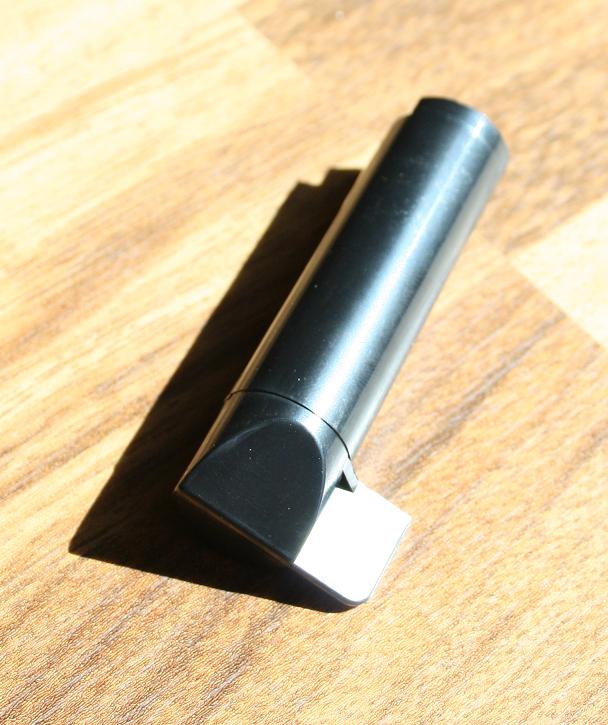
It is pushed into the chamber / barrel just like a shell, by turning it you can then calibrate the Hopup.
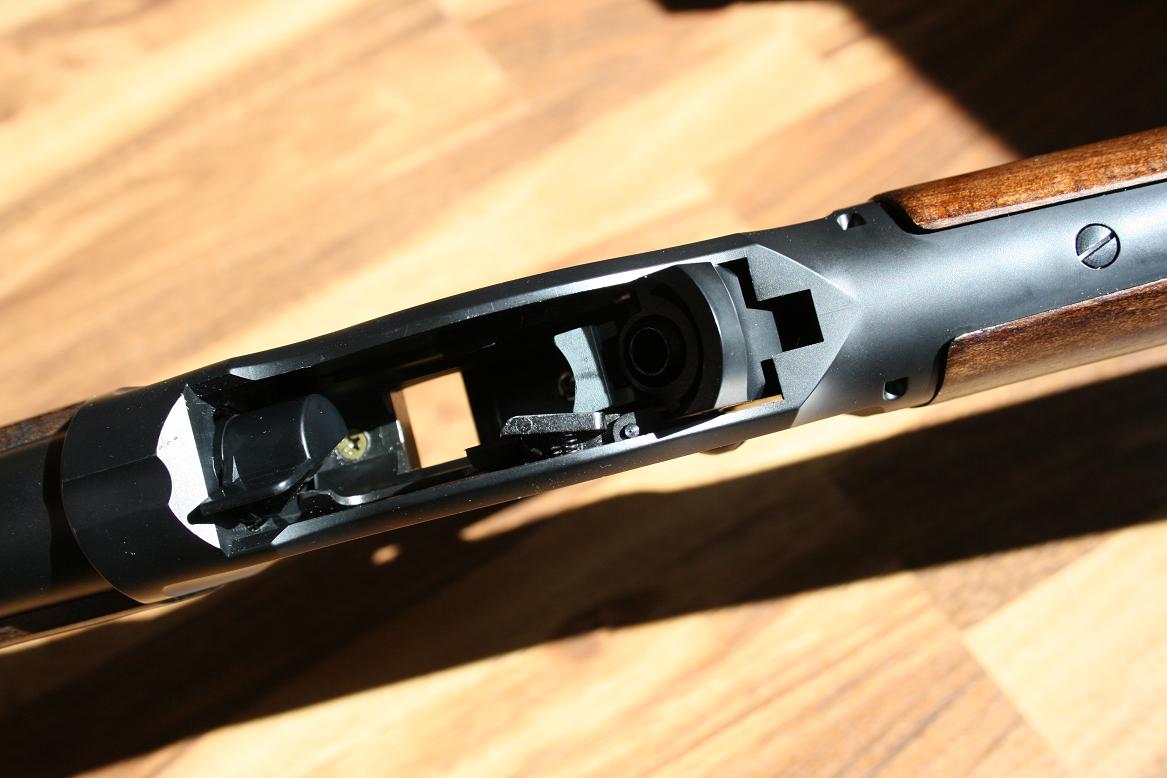
Tuning
To sum it up: No

Well, you can get real wood parts for the M1887 T2 version, but that’s about it.
External accessories would make the gun look utterly stupid (maybe like those cheap MP40 airsoftguns with REDDOT sights on top! AAAARGH!) and to tune it internally would have to be punished by law as it already is far too powerful for an airsoft gun.
It's not even meant to be carried with a sling, there are no possible attachment points, so that's ruled out, too.
There is ONE single item that you might consider to buy: A nice leather belt with loops for the shells

Conclusion
The conclusion regarding the Marushin M1887 – be it the „Guard’s Gun“ or the T2 version – sounds a lot like the conclusion of many other airsoft guns I own: It’s a collector’s piece, that is totally unsuited for airsoft games.
It’s a shell ejector, which in itself rules out an efficient commitment in airsoft games most of the time, additionally it’s too strong to actually use it against anything, that is not a paper target or a tin can.
Thus, the M1887 is another one of those Marushin guns, that only find their place in a collector’s showcase. Of course, a dainty collector might complain about the not 100% accurate shape of the stock, but when you’re a collector of „old“ firearms-replicas you don’t want to pass on the M1887. It is a very unique piece inside the modelgun AND airsoft world, there is no other gun like it. Which other gun provides the fun to have shells thrown directly TOWARDS you?

This gun has easily made it to the top 3 of my alltime „FUN-guns“ and is regularly taken out and „played with“ :)I hardly ever shoot it, it's satisfying enough to just load it up and dry-fire & repeat until all the shells are lying on the ground

I'm not entirely sure, if these are still produced... however, I can give only one advice:
Get one, if you have the chance! 
